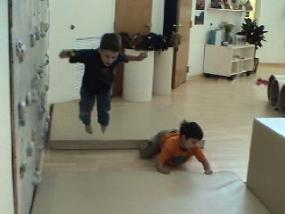Why Children Make Play Challenging

In this video episode, you will see three boys, about five years old, pretending to jump over a crevice flowing with hot lava. This invented adventure occurs because 1) the boys were previously acting out scenes from a television show that all know and 2) the affordances of the two gym pads present a convenient context for jumping over a defined distance. Fortunately, the pads can be moved. The boys, by degrees, increase the gap, thereby increasing the danger and fun of the game. They even invent the jump and roll to accentuate the feeling that the gap is wide and difficult to clear. As all three boys enter the pretense of jumping, the boy in the grey tie-dye shirt decides to add a new element, a lava ball hurling through space. He announces that the Nerf ball he throws is lava, and the boys first fall in pretend injury when hit and later dodge when the lava ball comes close.
This episode demonstrates several dynamics of pretend play. The boys increase the challenge to the maximum difficulty that still allows mastery. Once the pads reach that distance, the boys turn to other variations, such as falling to a roll or hurling lava balls. Each boy finds a way to take some initiative in inventing the rules of the game. For example, the boy in grey adds the hurling lava. Notice also for this rule he makes it difficult. He prefers to stand on the opposite side of the gap before throwing the Nerf ball. This choice increases the difficulty of hitting anyone, but at the same time, gives the boys more opportunity to see the trajectory and thereby get excited about the pending disaster.
We see that pretend play gives children the opportunity to set objectives at a level that is challenging but not impossible, to assert leadership, to identify roles, (e.g. taking turns to throw the Nerf ball), to bond as they create a shared script, to get some aerobic exercise, to listen to new rules offered by one another, and to invent extensions to those rules without losing the over-arching theme of the game.
We observe the boy in the dark blue shirt shooting a pretend gun and speculate that this action is used to convey the real and imminent danger of the situation. Perhaps, there are pretend enemies lurking nearby. In your opinion, should a teacher intervene whenever shooting occurs or do you think it depends on the context of play, the target, the possible danger to other children, and other specifics of a particular play episode?
Keywords: Fives, Child-Child, Pretense, Co-construction, Movement
Length of stand alone master video clip: 2 minutes 21 seconds
